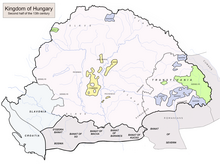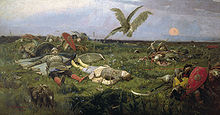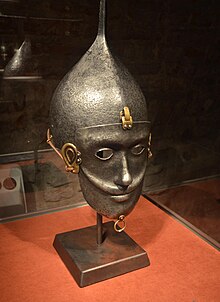Kipchak (people)
The Kipchaks (Qipchaq, Qipčaq or Germanized Kipchaks ) originally came from the Irtysh River , where they formed a Turkic-speaking clan within the Kimek tribal federation . It is believed that their origins are identical to those of the Gaoche ( Chinese 高 車 , Pinyin Gāochē , W.-G. Kao-che ; also known as Gaogüy or Kao-kü ).
In many European languages, such as the Germans , this is nomadic people frequently than Cumanians referred, however, in the Slavic languages from the Russian -derived form of name Polowzians ( Russian половцы "Field People / steppe people") prevails.
Name variants
Muslim authors have handed down the name Kıpçak . Further variants and different transcriptions of the name of this ethnic group are Kipchaks, Kyptschaks, Qipchaq, Qibchaq and Qipcaq .
In the Eastern Slavs , as in Igor's , they are as Polovtsian, Polovtsian, Polowcer or Polovtsian known and in the West Europeans and Byzantines as Cumanians or Kumans .
language
The Kipchaks are the namesake of what is now called Kipchak (or Cypchak ). This is an early representative of today's Kipchak languages .
Sparse and imprecise evidence of the Kipchak language can be found in the diwān lughāt at-turk of Mahmud al-Kāshgharī .
The language known today as Kipchak is a modern name for a historical Eastern European Turkic language, the evidence of which comes from the period after the fall of the Kipchak. The naming was mainly because among the Muslims the former area of the Kipchak in the Eurasian steppe retained the name Dašt-i Qipčaq (Kipchak steppe , another spelling Dascht-i-Kipchak ) even under Mongolian rule . The certificates reflect inconsistent, inconsistent dialects.
One of the sources of knowledge of Kipchak is the Codex Cumanicus , a manuscript that was written between 1303 and 1362. Last year the Italian poet Petrarch donated them to the Republic of Venice . Since then it has been in the library of St. Mark's Basilica . It probably comes from the missionary work of the Franciscans on the Lower Volga in the empire of the Golden Horde . The Codex Cumanicus contains grammatical paradigms, Turkish-language-Persian-Latin word lists, Turkish-language-German vocabulary lists and texts in a Turkic language that represent translations of religious texts from Latin. The orthography of the Turkish language texts in the Codex Cumanicus reflects the Italian and German origins of the various authors. The language itself is referred to as Comanic ( comanicum or chomaniche ) in the Latin remarks of the Codex Cumanicus , but in the Turkish-language parts as tatarče and tatar til , i.e. as Tatar. The word "Kipchak" occurs in the Codex Cumanicus only as a country name.
The rule of the Mamelukes in Syria and Egypt (1260–1517, including the Bahri dynasty 1279–1382 from the Kipchak steppe) led to the emergence of Turkic-language literature in Arabic script in these areas, on the one hand lists of words and linguistic treatises, on the other included religious and secular works. The Mamelukes were military slaves of Turkish and Circassian origin from the domain of the Golden Horde. In this literature there are also influences of the early Ottoman . The earliest work of this literature dates from the year 1245, the last from the year 1619. The language is mostly referred to as Turkish , sometimes also as qifǧaq (Kipchak). Another text corpus consists of documents of the Armenian community in Armenian script from the years 1559 to 1664 in Kamenez-Podolsk , in addition there are isolated writings from the 16th and 17th centuries in Armenian script. These scripts come from the descendants of Armenians who, after the fall of the medieval Bagratid Empire , first settled in the Crimea, where they had adopted the Turkish language of their surroundings while preserving their faith and maintaining their script. Parts of these Armenians were accepted into western Ukraine from 1280 onwards.
Around 1300 Jean de Joinville reported in detail about the strange gestures of friendship and burial rituals of the Cumans, which the French Philippe de Toucy had witnessed decades earlier .
history
Beginnings
The Kipchaks living in the Altai region came under the rule of the Kök Turks in the 7th century . Their khaganat existed until 742; after its decline they became part of the Kimek-Kipchak Federation, which established a khaganate around 880. In the following period part of the Kipchak migrated further and further west. From the part that remained in the east, the army of the Khorezmian Empire was recruited from the middle of the 12th century . The khaganate disintegrated around 1050, individual khanates continued to exist until they were conquered by the Mongols .
In the 12th century the originally independent federations of the Kipchak and Cumans merged.
Hike west
The Kipchak migrating westwards reached the land on the Volga and the steppe areas of the Ukraine around 1054 . There they in turn displaced the Pechenegs resident there across the Danube and invaded Hungary for the first time in 1071 .
The Kipchaks fought several wars against the East Slav peoples of the Kievan Rus and lived mostly semi-nomadic . In addition, they also owned smaller trading towns.
In southern Russia and Ukraine
The Kipchaks usually had several princes. After the decisive defeat of the Pechenegs , the following khans are recorded: Altunopa, Tugorkhan, Scharukhan and Boniak (around 1091). In 1093 the Cumans briefly overran Kiev . Tugorkhan fell in 1096 in a war against the victorious Russians. After Tugorkhan's death, Boniak apparently became the highest-ranking Khan for a long time and also the hero of numerous Russian chronicles.

Sharukhan (around 1107) owned four of the six cities of the Kipchaks. His son was Otrok, who had to flee to the Georgians after two victories by the Russian princes over the Don Kipchaks in 1111 and 1116 . There he founded the future Kipchak-Georgian alliance with a marriage. In 1125 , after the death of the Kiev Grand Duke Vladimir Monomakh , he returned. According to legend, his relatives who stayed behind brought him wormwood from the native steppe, the smell of which made him return. In 1154 the Cumans had regained their position, Sharukan (today's Kharkiv ) developed into a center of power.
Otrok's sons were Eltut and Könchek (approx. 1172–1201). Both were involved in changeable battles with the Russian princes, in which Eltut was killed in 1180 . In 1183 , Köbek (Kobyak), another Kipchak khan , was also defeated and captured along with his entire family. Könchek countered several times and finally succeeded. 1185, the campaign failed Prince Igor from the Tale of Igor . But Könchek was not the only prince - his (allied) rival was the ruler Kza Khan.
In 1223 the Mongols and the Turkic peoples allied with them appeared in the southern Russian steppes under the generals Jebe (Jelme) and Subutai . As a result, in 1223 a delegation of Cuman Muslims asked the caliph in Baghdad for help in vain. The Russian-Kipchak alliance, which had come about rather hastily, was defeated by the Mongols in the Battle of the Kalka , and soon afterwards the Mongols defeated the Kuman Khan Kuthan (Kötöny, Kotjan) again.
The final downfall of the Kipchak came with the campaign of Batu Khan in 1236-39, especially the defeat of Batschman, who was killed in 1238 on a Volga island . Part of the people, 40,000 families, fled in 1239 under Kuthan Khan (1202–1241) from the Mongols to Hungary , where they subsequently served as mercenaries . When the agreed acceptance of Christianity faltered (part of the Kipchak was Muslim, the majority pagan), rivalries with the Hungarian and German nobility intensified and Kuthan (Kötöny) was murdered, the Cumans left Hungary for a short time and moved to Dobruja , where The Bulgarian Tsar Kaliman offered them settlement areas.
In the Balkans

Together with the Byzantines , the Cumans defeated the Pechenegs in 1122 and largely destroyed them; the remains of their empire (Wallachia) fell to the Cumans in 1171. Since 1186 the Cumans fought alongside the Bulgarians against the Byzantines and in 1205 for the Bulgarians against the Latin Crusaders of Constantinople. After the defeat in the Battle of Kalka , 10,000 Cumans fled to Byzantium, in 1237 they also hired themselves out as mercenaries for the Latins against the Bulgarians and Byzantines.
In 1242 they were defeated by the Golden Horde (Mongols) on the side of the Bulgarians . In 1280, Georg I Terter, a Kumane, probably ascended the throne of the Bulgarian Tsar , but had to submit to the Golden Horde from 1285-1300. His descendants (see House Terter ) ruled until 1323.
In Hungary


The Tatar storm had caused the Cumans to flee further and further west until they had received permission from King Béla IV in 1239 under Kuthan Khan (1202-1241) to settle on Hungarian territory between the Danube and Tisza . The king had granted the seven tribes extensive special rights, hoping with their help to weaken the potent position of the Hungarian nobility. Three years later, in 1241, they were defeated as Hungarian allies in the battle of Muhi against the Golden Horde. King Béla's defeat had a devastating effect on his empire. Hungary was largely devastated by the Mongols and largely depopulated by numerous massacres; there are estimates that of the two million people who are said to have lived in Hungary in 1240, half fell victim to the Mongol storm and a further half a million in the course of the subsequent famines and epidemics died. The turning point came with the unexpected death of the great khan Ögedei , whereupon the Mongol threat was initially averted. In the period that followed, King Béla IV began to rebuild his country, with the Cuman tribes forming the backbone of the army with which the Hungarian king led his campaigns in the future. In 1262 King Béla IV succeeded in repelling a Mongolian invasion for the first time with the help of Cumans.
Under King Ladislaus IV (1272–1290), László, called the Kumane , the Cuman influence on the kingdom increased even more. Towards the end of the 14th century they also appeared as the guard of the Hungarian King Sigismund .
In the middle of the 14th century the Cumans were Christianized and Roman Catholic, after the Reformation in the 16th and 17th centuries. In the 19th century, however, some sub-groups converted to Calvinism . Their settlement area in Hungary was the northern part of the Alföld including the areas bordering on Körös and Maros . Some of the Cumanian privileges in the kingdom were revoked by the Ottoman administration around 1638 . With the “Redemptio Diploma” from Maria Theresa in 1745, the special rights were reintroduced and only abolished in 1876 under Kálmán Tisza .
Despite the long-standing special rights, the Turkic language of the Hungarian Cumans was gradually replaced by the Hungarian language over the modern era . The last known native speaker of Hungarian Cumanian was István Varró from Karcag , who died in 1770 , with whom the language was still researched and documented.
In the middle of the 19th century, the scattered settlement areas of the Cumans in the Pannonian Plain were combined to form the Jazygia and Cumania counties , with the administrative seat in Jászberény .
After the Austro-Hungarian Compromise of 1867, the Kingdom of Hungary began an aggressive policy of Magyarization , which was directed against all non-Magyars in the empire (ergo also against the Cumans). In this sense, all special Cuman rights were abolished in 1876 together with Jazygia and Cumania counties . The Magyarization achieved great success with the Cumans in the following period, the Cuman culture was almost completely absorbed by the Magyar.
traces

The fight of the Kipchaks with the Russians is described in the Igorlied , an old Russian hero epic . Even Alexander Borodin's opera Prince Igor is about. The Polowetz dances are particularly known from it.
In Hungary, the traces of the Kipchak or Cumans ( Hungarian : Kun ) have been preserved in the area names Nagykunság ( Greater Cumania , capital Karcag ) and Kiskunság (Small Cumania ) and corresponding place names such as Kunszentmárton, Kunszentmiklós and Kiskunfélegyháza (capital of Small Romania).
For a long time the Hungarian Pechenegs and Cumans were considered the ancestors of the Transylvanian Szeklers , the Bulgarian Pechenegs and Cumans as the ancestors of the Gagauz .
In Russia, five citizens identified themselves as Polovzians at the 2003 census, but this was not taken seriously by the authorities and was not included in the final report.
The North Macedonian city of Kumanovo is named after the Cuman people.
literature
- Otto Blau : Ueber Volksthum und Sprach der Kumanen , In: ZDMG, Volume 29 (1875) ULB Halle
- Jeremiah Curtin: The Mongols in Russia. Sampson, London 1908.
- Peter B. Golden : Nomads and their neighbors in the Russian Steppe. Turks, Khazars and Qipchaqs (= Variorum collected Studies Series CS752). Ashgate, Aldershot et al. 2003, ISBN 0-86078-885-7 .
- István Gyárfás: Jász-Kunok története. 4 volumes. Szilády, Kecskemét 1870–1885 (reprint: Kiadja “A Jászságért” Alapitvány, Budapest 1992, ISBN 963-04-2444-4 ).
- György Györffy: A magyarsag keleti elemei. Gondolat, Budapest 1990, ISBN 963-282-251-X .
- András Pálóczi Horváth: Petschenegen, Kumanen, Jassen. Steppe peoples in medieval Hungary. Translated from the Hungarian by János Thimar. Linguistic processing by Friedrich Albrecht. Corvina, Budapest 1989, ISBN 963-13-2739-6 .
- Pál Hunfalvy : Magyarország ethnographiája. Könyvkiado-hivatala, Budapest 1876 (German: Ethnography of Hungary. With the consent of the author, translated into German by JH Schwicker . Franklin-Verein, Budapest 1877).
- Светлана. А. Плетнёва: Половцы. (Russian) Moscow 1990, ISBN 5-02-009542-7 . Partial English translation of the book with comments: [1]
- Kumans in Bulgarian History (Eleventh-Fourteenth Centuries). In: Hasan Celâl Güzel et al. (Ed.): The Turks. Volume 1: Early Ages. Part 9: Turks in East Europe. Yeni Türkiye, Ankara 2002, ISBN 975-6782-56-0 , pp. 680-689.
- Lajos Ligeti: A Codex Cumanicus mai kérdései (= Keleti értekezések 1). Kőrösi Csoma Társaság, Budapest 1985, ISBN 963-01-6377-2 .
- Denis Sinor et al. (Ed.): The Cambridge History of Early Inner Asia. Cambridge University Press, Cambridge et al. 1990, ISBN 0-521-24304-1 .
- István Vásáry: Cumans and Tatars. Oriental military in the Pre-Ottoman Balkans, 1185-1365. Cambridge University Press, Cambridge et al. a. 2005, ISBN 0-521-83756-1 .
Web links
Individual evidence
- ↑ Polowcer
- ^ Gyula Moravcsik: Byzantinoturcica, part 2. Budapest 1943, page 148 f.
- ↑ Omeljan Pritsak : The Kipchak in Philologiae Turcicae Fundamenta. Volume 1, Wiesbaden 1959, p. 74.
- ↑ JA Boyle, Da sh t-i Ḳipčaḳ. Encyclopaedia of Islam , Second Edition. Brill Online, 2013 here seen on January 29, 2013
- ^ Annemarie von Gabain : The language of the Codex Cumanicus in Philologiae Turcicae Fundamenta , Volume 1, Wiesbaden 1959, p. 46 ff.
- ^ Omeljan Pritsak : Das Kiptschakische in Philologiae Turcicae Fundamenta , Volume 1, Wiesbaden 1959, pp. 74 ff.
- ↑ a b c Encyclopaedia of Islam X: 686b or X: 687a, article about Turks ( Memento from December 6, 2005 in the Internet Archive ) (3. The Turks of Western Eurasia and Central Europe)
- ↑ Barbarii cumani, strămoşii noştri? , Răzvan Theodorescu, Historia.ro (Romanian)
- ↑ Encyclopaedia of Islam : Article on Bulgaria (I: 302a)
- ↑ Severien Salaville: Un peuple de race turque christianisé au XIIIe siècle: les Comans. in: Échos d'Orient 1914, vol. 17, no. 106, pp. 193-208 (penultimate paragraph and last footnote). Salaville uses the first name Etienne , a translation of the Hungarian István , or German Stephan .
- ↑ Russia currently from November 15, 2003: Surprises in the great population census



